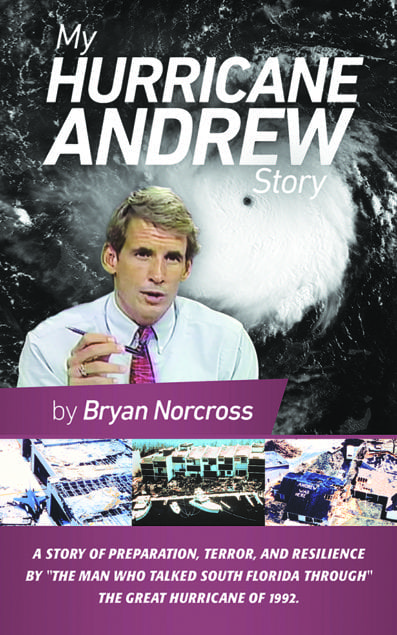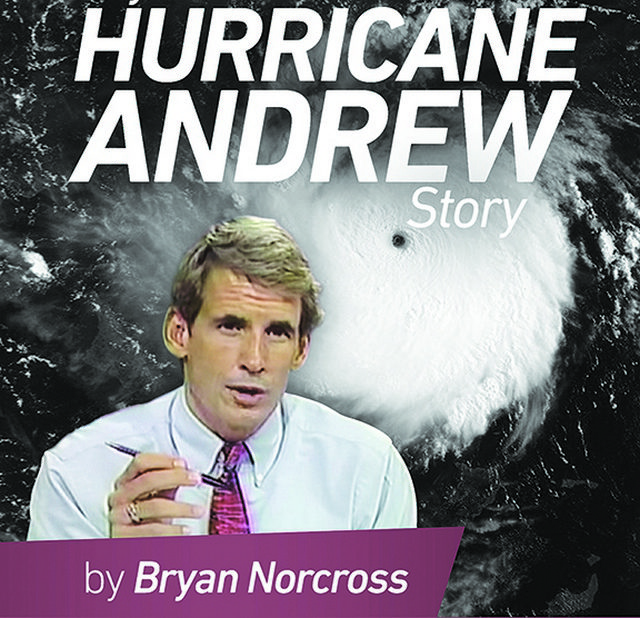
It almost doesn’t seem possible for those who went through it, but Hurricane Andrew and its devastating effects upon South Florida happened 25 years ago — a quarter century — on Aug. 24, 1992. Bryan Norcross’s new book, My Hurricane Andrew Story, brings the event vividly to life.
Norcross relates in a highly readable and detailed behind-the-scenes fashion the days and hours leading up to the category 5 hurricane’s approach and collision with southern Miami-Dade County, destroying or heavily damaging thousands of homes and businesses and suspending normal activity for weeks or months.
My Hurricane Andrew Story is the story behind meteorologist Norcross’s TV coverage, and how he was first to raise the alarm. The book, told from his vantage point, relates untold stories about the storm, one which rewrote our understanding of hurricanes.
Norcross began his career at CNN serving as the cable network’s first weekend meteorologist. After weather jobs in San Francisco and Atlanta, he was on television in Miami for 25 years on WPLG, WTVJ, and WFOR. From 1996 to 1999, he was anchor of the 5:30 p.m. news
on WFOR, in addition to director of meteorology for the station. Bryan joined The Weather Channel as senior hurricane specialist in 2010.
“I love the Weather Channel,” Norcross said. “The people there are fantastic. It’s very different from working in a local market.”
Norcross grew up on the coast of Central Florida and is a longtime resident of Miami Beach.
Before Hurricane Andrew, most people in South Florida had a lack of experience regarding hurricanes and didn’t take them seriously. Has that changed?
“I think that the situation overall is worse today than it was before Andrew,” Norcross said. “We still have a tremendous number of people who don’t appreciate what can happen in a hurricane like Andrew, but also we have so many more people who have so much more wealth piled right along the coast.
“What I think the biggest public safety problem is that the ability to communicate with people is so much less robust now than it was in 1992 even. Our communications systems are more fragile today than before. Back then just about everybody had a transistor radio and people had landline phones that were connected by a copper wire to the central office, so even if your power went out you still had a working phone,” he said.
“Add to that, in the modern world communication is so much more fragmented because you get information from every direction — online and social media, websites and TV channels. It’s just harder to get a cohesive message to people today than it was at that time.”
Norcross said that predicting the path of storms will continue to improve, but will never be perfect.
“We’re still not very good with storms that are relatively weak or that are not moving very fast or that don’t have well defined circulation, and two of those factors were true of Hurricane Andrew a few days before it hit,” Norcross said.
And what impact will a warmer climate have on storms?
“There is no evidence at all that we are having more or stronger hurricanes or that there’s any change in storms related to the warmer world…yet,” h said. “The evidence that we have for the future is that we’ll have fewer hurricanes but stronger hurricanes. That’s the consensus of the computer simulations of a warmer planet.”
Norcross said that he hopes readers take away two things from his book.
“The main point is that the worst does happen. People tend to think when they hear the warnings that the storms usually miss us, but the lesson of Andrew was that sometimes the storm doesn’t jog away from you, it jogs toward you. Sometimes it doesn’t weaken when it approaches the coast, it gets stronger, and sometimes it continues to strengthen even after it comes ashore. Hurricane Andrew did all those things,” he said.
“It doesn’t happen often, but good sense says that we need to prepare for the worst reasonable case. The other lesson is that preparedness works. WTVJ’s and my experience with Andrew is testament to the fact that if you prepare for an extreme situation, sometimes you will need that preparation and it can make a tremendous difference in what happens after the storm.”
Norcross will be signing copies of his new book at Books & Books on these dates:
Thursday, Aug. 15, 7 p.m., 927 Lincoln Rd., Miami Beach;
Saturday, Aug. 19, noon, 9700 Collins Ave., Bal Harbour;
Tuesday, Aug. 22, 6 p.m., 11297 S Dixie Hwy., Pinecrest, and
Tuesday, Aug. 29, 7 p.m., 1300 Biscayne Blvd. Miami.
His book also can be found online: www.amazon.com/Hurricane-Andrew-Story-preparation-resilience/dp/0998992216.






